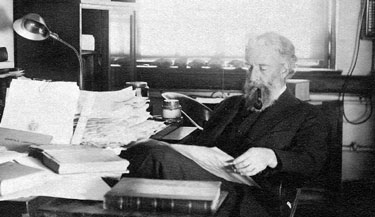
1867–1934
-
Geophysical Laboratory, staff member (1912-1934)
-
A.B. in Physics, Yale University, 1888
-
Ph.D., University of Leipzig, 1893
-
National Academy of Sciences
-
Geological Society of America, vice president
-
American Geophysical Union, vice president
-
Mineralogical Society of America, president
-
Academie de France
-
Washington Academy of Sciences
-
Italy’s Order of the Crown, cavalier
-
Geological Society of London
-
Societa Geologica Italiana
-
The Modena
-
Norway and Turin Academies
|
Henry Stephens Washington began his scientific career at the age of twelve when an old smokehouse on his family’s estate was remodeled into a chemical laboratory for quantitative analyses. He continued his studies in college, concentrating on the natural sciences and physics. Washington’s favorite area of research was petrology, the study of rocks and their origins. In 1897, he analyzed a collection of rocks from Norway. When he compared these rocks to a group found in Essex County, Massachusetts, Washington discovered that the rocks shared almost the same mineralogical and chemical compositions. This was a huge breakthrough in his research, as the rocks were formed by completely different magmas. The results of this find led to Washington’s 1898 proposal for a system of classification for igneous rock nomenclature. He wasn’t alone in his interest. J. P. Iddings and Whitman Cross were also toying with the same idea. Beginning in 1899, Washington, Iddings, Cross, and J. V. Pirsson worked for three years to create the first systematic, quantitative, and chemico-mineralogical classification of igneous rocks. This system is now known as the CIPW norm. According to J. Volney Lewis, the cooperation of these four scientists was one of the earliest and smoothest collaborations in the history of geoscience. Washington went on to detail the CIPW system in a series of articles in The Journal of Geology in 1902. His most famous book, the Chemical Analyses of Igneous Rocks, published in 1903, contains over eight thousand different rock analyses. |
|||
|
|
|||
|
|||
|
|
|||
|
Washington was also instrumental in planning the Carnegie’s Geophysical Laboratory in Washington, D.C. He and seven other scientists helped to plan the Laboratory’s initial research program. In 1912, seven years after its foundation, Washington joined the Geophysical Laboratory as a staff member. In 1914, he accompanied the Laboratory’s director, Arthur L. Day, on an expedition to several active volcanoes in the Mediterranean. This volcanological study, and the many others that followed, resulted in a volume of papers on igneous rocks from several Mediterranean islands like Sardinia, Pantelleria, and Stromboli, and also Brazil, Colorado, India, and Rockall, a rocky Northern Atlantic islet. During his life time, Washington published 169 works contributing to archaeology, regional and descriptive petrology, geochemistry, geophysics, and mineralogy. Washington’s work defined his time, and creations like the norm calculation continue play a key role in petrology over a hundred years after its invention. Though Washington's calculation wasn't the first norm, it is still the one most widely used and accepted today. Washington was an interesting character. He was fluent or proficient in a number of languages, including German, French, Italian, Greek, Spanish, Portuguese, Arabic, and Turkish. Washington boasted a profound love of archaeology, and even published a poem entitled Ave Rome immortalis in honor of Italy. "His interest in archaeology was permanent, and he repeatedly applied chemical and petrographical methods to the study of its special problems," noted close colleague, Whitman Cross. Washington was a many of many talents. His immense span of knowledge ranged from the most complex geological problems to Italian literature. He contributed to many fields of study, but it will always be petrology that benefitted the most from his work. |
|||
|
|
|||
|
References:
Further Reading:
|

